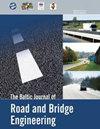沥青层密度和空气空隙含量:探地雷达和实验室测试数据的可靠性
IF 1.1
4区 工程技术
Q4 ENGINEERING, CIVIL
引用次数: 8
摘要
沥青路面压实度的保证是衡量沥青路面耐久性的主要标准之一,用现场和实验室体积密度与空隙率的比值来表示。应采取破坏性措施,并从沥青路面上取芯,以确定施工沥青层的代表性压实水平。人们不断寻求新的方法来快速、无损和准确地测定道路上的沥青层密度和空隙率。探地雷达(GPR)可以在不损坏道路结构的情况下,确定整个道路上沥青路面的定性特征。相对介电常数,通常称为介电值或常数,是GPR在道路路面调查中应用的主要特性。本文介绍了四个试验段沥青基层和粘结层的GPR测量结果。GPR测量是在沥青层压实过程结束后立即进行的。选择每层的测试点,通过钻孔取芯并在实验室进行测试来确定密度和空隙率。为了估计沥青层密度和空隙率,使用不同的现有数学模型分析了GPR数据。为了证明GPR测量数据的可靠性,通过将其与直接在沥青路面层的岩芯上测量的结果进行比较来检查结果。本文章由计算机程序翻译,如有差异,请以英文原文为准。
Asphalt Layer Density and Air Voids Content: GPR and Laboratory Testing Data Reliance
The assurance of asphalt pavement layer compaction, expressed by ratio between field and laboratory bulk density and air voids content, is one of the main criteria of the durability of asphalt road pavement. Destructive measures should be applied and cores should be taken from the asphalt pavement seeking to determine the representative compaction level of the constructed asphalt layers. New methods are constantly being sought for fast, non-destructive and accurate asphalt layer density and air void determination on road. Ground Penetrating Radar (GPR) can allow determining the qualitative characteristics of asphalt pavement across the entire length of the road without causing damage to the road structure. Relative dielectric permittivity, usually called dielectric value or constant, is the leading property used in GPR applications on road pavement surveys. This article presents GPR measurement results from asphalt base and binder layers of four test sections. GPR measurements were conducted immediately after the end of asphalt layer compaction process. Test points on each layer were selected and density, air void content were determined by drilling cores and testing them in the laboratory. To estimate asphalt layer density and air void content, GPR data were analysed using different existing mathematical models. To justify the reliability of the data measured by GPR, results were checked by comparing them with the results measured directly on cores taken from the asphalt pavement layers.
求助全文
通过发布文献求助,成功后即可免费获取论文全文。
去求助
来源期刊
CiteScore
2.10
自引率
9.10%
发文量
25
审稿时长
>12 weeks
期刊介绍:
THE JOURNAL IS DESIGNED FOR PUBLISHING PAPERS CONCERNING THE FOLLOWING AREAS OF RESEARCH:
road and bridge research and design,
road construction materials and technologies,
bridge construction materials and technologies,
road and bridge repair,
road and bridge maintenance,
traffic safety,
road and bridge information technologies,
environmental issues,
road climatology,
low-volume roads,
normative documentation,
quality management and assurance,
road infrastructure and its assessment,
asset management,
road and bridge construction financing,
specialist pre-service and in-service training;

 求助内容:
求助内容: 应助结果提醒方式:
应助结果提醒方式:


